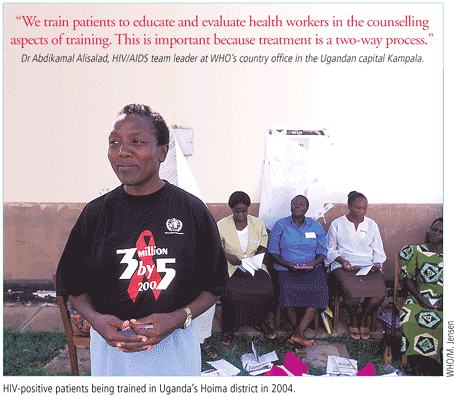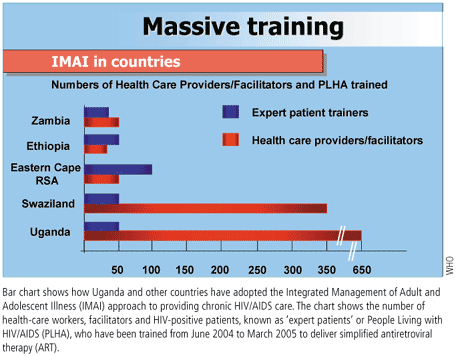NEWS
IN FOCUS
Uganda leads way in innovative HIV/AIDS treatment
Charles Wendo
Kampala
Public health officials and doctors in sub-Saharan Africa say innovative approaches to treating AIDS in poor settings have so far been successful on a small scale. Can these efforts be expanded to provide antiretroviral therapy (ART) on a massive scale? Uganda is one of the sub-Saharan countries that has led the way in the treatment scale-up. But while the country is expected to reach the 50% treatment target, scaling up to provide ART treatment for every Ugandan who needs it will be a major challenge.
Building on years of AIDS awareness and prevention programmes, Uganda has almost completed training of health staff in all of its 56 districts to deliver a simplified version of chronic HIV/AIDS care that includes ART to people living with HIV/AIDS.
So far, just over one-third of patients in Uganda who need antiretroviral (ARV) drugs were receiving them at the end of December 2004 and the proportion is expected to reach 50% by July. This might appear low, but it is one of the highest proportions in Africa.
According to the '3 by 5' progress report released by WHO in January, 72% of people in Africa who need ARVs were still not getting them at the end of last year. Botswana was the only African country that had reached the 50% target level by that time, the report said.
Many public health experts believe that the main obstacle to the '3 by 5' campaign, which aims to scale-up delivery of ART to at least three million people in poor countries by the end of 2005, is the severe and growing shortage of health workers.
In an editorial on page 243 of this issue, Lincoln Chen, Director of the Global Equity Initiative, Harvard University, calls on governments for urgent action to address this shortage. Government officials from many countries gathered in Abuja, Nigeria last December conceded that the shortage of health workers in Africa threatened to derail development goals on the continent (Bulletin Vol. 83. No. 1, pp. 56).
In Uganda, officials say there are enough staff to treat the 42 000 patients currently on ARV drugs, but that more human resources and more drugs are needed to scale this up to the remaining 58 000 in need of treatment too.
Of those 42 000, three-quarters are paying for ARV medicines out of their own pockets, while a quarter get the drugs free from the Ugandan Government and donor projects.
Rosette Mutambi, coordinator of the Uganda Coalition for Access to Essential Medicines, argued that more should be done to make free and partly-subsidized ARV drugs more widely available. Mutambi said she feared emphasizing the shortage of health workers could slow down funding for ARV drugs in Africa. "The issue of human resources is not a problem at the moment, but it may be in future," Mutambi told the Bulletin.
Dr Elizabeth Madraa, Manager of Uganda's AIDS Control Programme, said that the workforce shortage was already a constraint and that this was largely due to the 'brain drain' of doctors and nurses. She said Uganda's medical schools and nursing colleges do not produce enough doctors and nurses, and that there is a lack of public funds to recruit adequate numbers of health workers.
"We keep training and they go to NGOs (nongovernmental organizations) or abroad where they can get better money, then we have to train [more people] again," said Madraa, who organizes and oversees ART training for health workers across Uganda.

In order to overcome the financial and staffing constraints, Uganda has adopted what Madraa called an "innovative" approach to treating HIV/AIDS patients.
Uganda is the first sub-Saharan country to roll-out ART on a national level taking this innovative approach. Ethiopia, the Eastern Cape region of South Africa, Swaziland and Zambia have also started training health workers to provide HIV/AIDS chronic health care using this simplified approach (see graph). If successful, Uganda's ART roll-out could serve as a model for other low-income countries.
In contrast, Botswana is providing HIV/AIDS chronic care taking a similar approach to European and North American countries which can be much more costly in terms of human resources and medicines.
In contrast, the idea of the simplified approach to providing chronic HIV/AIDS care i s to train nurses to perform some of the tasks of doctors and lay health workers and community workers to carry out some of the nurses' work. Under these simplified treatment guidelines, patients are prescribed combination pills rather than several different medicines to be taken twice a day.
Madraa said that as long as a doctor diagnoses a patient or endorses the diagnosis of a nurse, and as long as the doctor writes the prescription, the counselling and supervision of drug intake can be done by other people.
She said the idea was also to encourage home-based and community-based ARV delivery to ease congestion in health facilities. If complications arise, the nurses and others refer patients to a doctor or a health facility.
"If you can make a good diagnosis, the counselling is good and the patient adheres to the drugs, I don't see how the level of qualification can be a problem," Madraa told the Bulletin.
"Unless we do things differently to address the human resource capacity gap, we shall never deliver even the basic health-care services, let alone ART," Madraa said.
In Uganda, more community workers need to be trained to counsel patients, ensure they are adhering to ARV treatment and to send them to hospital if there are complications or severe side-effects. Adherence is a vital component of ART because HIV/AIDS patients are expected to take their medicine every day for the rest of their lives.
This approach, called Integrated Management of Adult and Adolescent Illness (IMAI), has been inspired by successes in Latin America, the former Soviet Union and Africa, where lay health workers who are often relatives, friends or other community volunteers have been trained to help treat tuberculosis patients in poor settings.
IMAI is a health services delivery model characterized by simplified guidelines and training material. It is based on full involvement of nurses, lay health workers and in the case of HIV/AIDS chronic care HIV-positive patients who help to train health workers.
WHO and its partners are planning new research into whether services provided by nurses are comparable with the same services provided by doctors. If the studies provide favourable results, clinical officers and nurses may even be allowed to prescribe ARVs, currently the preserve of doctors.
The research will also try to establish whether clinical signs alone and as an alternative to laboratory tests are enough to decide when to start or change ART. Currently laboratory tests are a requirement for making these decisions in certain settings.
Dr Abdikamal Alisalad, HIV/AIDS team leader at WHO's country office in the Ugandan capital Kampala, said that the HIV/AIDS clinical team consists of: doctors, clinical officers, nurses, counsellors and laboratory technicians and that each has an important role to play in the delivery of ARVs.
Shifting some of these tasks to others can solve health workforce constraints. He noted that another innovative aspect of this approach is training HIV-positive volunteers as 'expert patients' who, in turn, help to evaluate and drill professional health workers.
"We train patients to educate and evaluate health workers in the counselling aspects of training," Alisalad told the Bulletin, adding: "This is important because treatment is a two-way process". 

